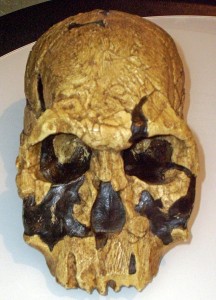Part IV: Pleistocene Epoch
24. Homo rudolfensis
Homo rudolfensis (2.4 mya)
(“human” / from Lake Rudolf)
SITES
Koobi Fora, Kenya; Chiwondo Beds, Malawi; possibly Olduvai Gorge, Tanzania
PEOPLE
Richard and Meave Leakey, Bernard Ngeneo

INTRODUCTION
The second species of Early Homo to be discovered is now known as Homo rudolfensis, since it was discovered at the site of Koobi Fora on the east side of Lake Turkana, which was formerly known as Lake Rudolf.
PHYLOGENY
Homo rudolfensis may be a descendent of Kenyanthropus platyops. Those who favor that scenario would either assign rudolfensis to genus: Kenyanthropus or move platyops into genus: Homo. There are proponents on both sides of the argument as to whether H. habilis or H. rudolfensis gave rise to the earliest member of the “erectus grade,” i.e. Homo ergaster in Africa, and its four descendent species: erectus in Asia, antecessor in Western Europe, georgicus in the Republic of Georgia, and floresiensis on the island of Flores.
DISCOVERY AND GEOGRAPHIC RANGE
The majority of Homo rudolfensis material comes from the Koobi Fora site where Richard Leakey discovered the type specimen, KNM-ER 1470 (see Figure 24.1) (Kenya National Museum – East Rudolf), as well as subsequent material. Material has also been recovered from the Chiwondo Beds of Malawi, and there is possible material at Olduvai Gorge. Thus, the species ranged from northern Kenya down through Tanzania and into Malawi, along the north-south hominin corridor.
Leakey originally called the material Homo indet. (“indeterminate”) because he did not know in what, if any, group to include it. The use of species: rudolfensis began to gain in popularity as researchers came to realize they were dealing with two distinct species. For a while, some were content with the two species being geographic species, i.e. H. habilis at Olduvai and H. rudolfensis at Koobi Fora. However, habilis-like material was discovered at Koobi Fora (KNM-ER 1813) and some material at Olduvai resembled H. rudolfensis. The two species went through a tumultuous period when the species names were abandoned by some, in favor of “Early Homo.” However, critics complained that it had become a “wastebasket” species. During that time, Richard Leakey visited SUNY Geneseo, and I had the opportunity to chat with him about the taxonomic problem. He was frustrated with the state of things and wished that paleoanthropologists would work out exactly what characterized the two species. Over time, paleoanthropologists have seemingly become more comfortable with the habilis designation for the majority of fossils from Olduvai Gorge, even if some of them prefer genus: Australopithecus. The same is true for the type specimen, KNM-ER 1470, as H. rudolfensis.
PHYSICAL CHARACTERISTICS
Relative to H. habilis, H. rudolfensis was larger and more robust, with a heavier face and jaws and larger dentition. Their faces were long, and the lower face was thought to be somewhat orthognathic based on the type specimen, KNM-ER 1470. New material discovered at Koobi Fora was thought to support the reconstructed facial morphology of KNM-ER 1470 and elucidate heretofore unknown aspects of the face and jaw. However, Bromage et al. (2008) have conducted architectural constraints analyses demonstrating that the degree of orthognathism would be biomechanically impossible. The molars were large with complex crowns and thick enamel like other contemporary and descendant species, but they were mesiodistally long and hence more primitive than H. habilis. The brain averaged 751 cc, but their encephalization quotient may have been only 3.0, versus the 3.1–3.5 range estimated for H. habilis. As mentioned, it is not known for certain that any of the postcranial material that some researchers assign to the species is justified. If the postcranial material belongs in the H. rudolfensis hypodigm, the following can be stated about the species: their innominate, femur (larger head, shorter neck, and robust shaft), and limb proportions were more modern, with longer legs and shorter arms, and the femoral robusticity corresponds to increased strain generated by a wider pelvic aperture.
Review of Primitive Characteristics
- Robust craniofaciodental characteristics.
- Primitive temporal region.
- Long molars (mesiodistally).
Review of Derived Characteristics
- Long orthognathic face?
- Large brain.
- Human-like limb proportions, innominate, and femora?
ENVIRONMENT AND WAY OF LIFE
While their environment did not differ from that of H. habilis, they may have been able to process tougher food items with their more robust masticatory apparatus. While tools are known from the time period and geographic region occupied by the species, tools have not been found in association with fossil material. It is possible that the more gracile masticatory apparatus of H. habilis could have resulted from tool use in food-processing activities and relaxed selection for robust features.

